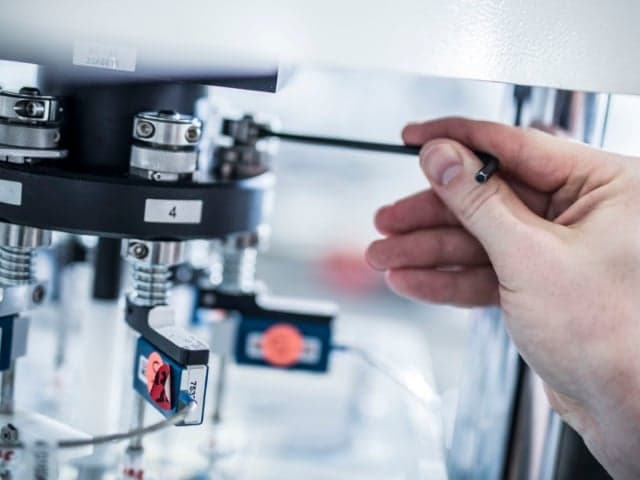Heart Valve Device Testing
Our heart valve durability testing validates devices under accelerated conditions to simulate 10-15 years of in vivo lifetime use. We test surgical and transcatheter heart valve replacement and repair devices with comprehensive protocols, providing the technical evidence you need for regulatory approval. Our specialized testing meets international standards while accelerating your development timeline.

What is Heart Valve Device Testing at Element?
Heart valve device testing evaluates surgical and transcatheter heart valve replacements and repair devices under accelerated conditions. At Element, we characterize heart valve prostheses using test methods tailored to your devices and their design, following applicable standards for regulatory compliance. Our testing simulates physiological conditions, including bending of leaflets and opening/closing cycles, to validate long-term performance and durability.

What Can Element Offer You For Heart Valve Device Testing?
Components and materials we test
Components and materials we test
We test complete heart valve devices, stent struts, support structures, and frames made from nitinol, braided wire, and bioabsorbable polymers. Our testing covers both surgical and transcatheter devices through specialized protocols. For stented valves, we specifically test the stent portion separately from the valve itself, evaluating high-strain portions and support structures through targeted analysis.
Key tests offered
Key tests offered
We provide in vitro durability testing through mechanical fatigue, stent strut fatigue testing, heart valve frame fatigue testing, and pulsatile fatigue loading for 400M or 600M cycles. Our testing includes detailed S-N curve generation for stent struts, with specialized protocols for different device components and configurations.
Tests we offer include:
- Heart valve durability testing
- Stent strut fatigue testing (S-N curve generation)
- Heart valve frame fatigue
- Device acceptance & failure criteria
Methods and solutions offered
Methods and solutions offered
We deploy stents inside mock vessels with physiologically-relevant compliance and hydrodynamic pressure to accurately replicate in vivo conditions. Our testing includes load monitoring and specialized fixturing to accommodate different specimen geometries. We can test 12-15 samples simultaneously while maintaining continuous monitoring of test conditions and specimen performance.
Heart Valve Durability Testing:
Element conducts in vitro durability testing for transcatheter heart valves, replicating in vivo conditions with mechanical fatigue to simulate 10–15 years of physiological strain. This is a crucial step in evaluating the implant's long-term performance.
Stent Strut Fatigue Testing (S-N Curve Generation):
For stented valves, we test the stent strut separately under high-strain conditions using customized fixturing. Multiple samples are tested simultaneously at different strain levels to generate stress vs. cycle curves (S-N curves), providing a comprehensive assessment of fatigue durability.
Heart Valve Frame Fatigue:
We evaluate bioprosthetic valve frames with pulsatile fatigue testing for 400M–600M cycles, simulating real-world conditions inside physiologically-relevant mock vessels. This ensures optimal performance, longevity, and fatigue resistance.
Device Acceptance & Failure Criteria
Manufacturers set specific criteria for device failure or acceptance, such as stent strut continuity or absence of visible cracks under 30x magnification after testing. We monitor these criteria throughout testing and provide detailed documentation of the specimens against the predefined criteria. We use ElectroForce test instruments for stent strut fatigue, along with visual, endoscopic, high-speed video, and strobe light inspections to assess device performance.
Cutting-edge equipment we use
Cutting-edge equipment we use
We utilize ElectroForce 3200 and 3300 test instruments for precise control of test conditions, supported by comprehensive inspection capabilities including visual examination, endoscopic analysis, high-speed video capture, and strobe light analysis for detailed performance evaluation.
Which labs offer this service
Which labs offer this service
Our expert team operates from strategically located medical device industry hubs, giving you convenient access to expert guidance. Find your nearest lab on our Locations Page.
Mock vessel testing capabilities
We first conduct testing with physiologically-relevant vessels to determine target strains for a given stent, followed by testing with thick-walled vessels for accelerated fatigue testing. This dual-approach enables higher frequency testing while maintaining appropriate loading conditions, supporting efficient validation of long-term performance.
Standards we test to and components we test
The main applicable heart valve test standards are:
- ISO 5840-1 Cardiovascular implants – Cardiac valve prostheses – Part 1: General requirements
- ISO 5840-2 Cardiovascular implants – Cardiac valve prostheses – Part 2: Surgically implanted heart valve substitutes
- ISO 5840-3 Cardiovascular implants – Cardiac valve prostheses – Part 3: Heart valve substitutes implanted by transcatheter techniques
- ISO 5910 Cardiovascular implants and extracorporeal systems – Cardiac valve repair devices
If the valve is stented to support the leaflets, the following standards apply for testing the stent portion of the device:
- ASTM F2477 Standard Test Methods for in vitro Pulsatile Durability Testing of Vascular Stents
- ISO 25539-1 Cardiovascular implants – Endovascular devices – Part 1: Endovascular prostheses
- ISO 7198 Cardiovascular implants and extracorporeal systems – Vascular prostheses – Tubular vascular grafts and vascular patches
- Nitinol stents and frames
- Braided wire support structures
- Bioabsorbable polymers
- Bioprosthetic valve materials
- Mock vessel materials
Your Challenges, Our Solutions
Efficient validation of long product lifetimes
Diverse testing requirements
Accurate replication of physiological conditions
Comprehensive inspection requirements
Why Choose Element

Testing expertise
Advanced equipment
Multiple inspection capabilities
Custom solutions
600M Cycles maximum pulsatile fatigue testing
30x Magnification for detailed inspection
12+Samples tested simultaneously
400MCycles frame fatigue testing capability


Explore our global network of labs and find your nearest location
VIEW ALL LOCATIONSRelated services

Cardiac & Endovascular Device Testing
Element offers comprehensive cardiac and endovascular device testing, providing fatigue and durability analysis to support regulatory compliance and product reliability for stents, heart valves, pacemaker leads, and more.

Coating & Particulate Testing
Element provides coating integrity and particulate testing for intravascular devices, helping manufacturers meet safety standards, improve device performance, and comply with regulatory guidelines.

Pacemaker Lead Testing
Pacemaker lead testing evaluates safety, performance, and compliance with industry standards. We simulate real-world conditions to help manufacturers bring safe, reliable cardiovascular devices to market.
Silicone Mock Vessels
Our cardiovascular device testing experts have extensive experience designing custom mock vessels for pulsatile fatigue testing and other test methods for devices such as stents, occluders, and heart valves.

Stent & Stent Graft Testing Services
Element provides expert stent testing services to validate cardiovascular device compliance, durability, and performance. Our comprehensive testing meets regulatory standards, supporting safe and effective device
